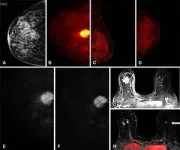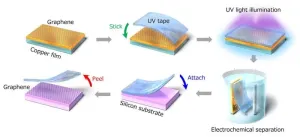(Press-News.org) OAK BROOK, Ill. – An innovative breast imaging technique provides high sensitivity for detecting cancer while significantly reducing the likelihood of false positive results, according to a study published today in Radiology: Imaging Cancer, a journal of the Radiological Society of North America (RSNA). Researchers said the technique has the potential to offer more reliable breast cancer screening for a broader range of patients.
Mammography is an effective screening tool for early detection of breast cancer, but its sensitivity is reduced in dense breast tissue. This is due to the masking effect of overlying dense fibroglandular tissue. Since almost half of the screening population has dense breasts, many of these patients require additional breast imaging, often with MRI, after mammography.
Low-dose positron emission mammography (PEM) is a novel molecular imaging technique that provides improved diagnostic performance at a radiation dose comparable to that of mammography.
For the study, 25 women, median age 52, recently diagnosed with breast cancer, underwent low-dose PEM with the radiotracer fluorine 18-labeled fluorodeoxyglucose (18F-FDG). Two breast radiologists reviewed PEM images taken one and four hours post 18F-FDG injection and correlated the findings with lab results.
PEM displayed comparable performance to MRI, identifying 24 of the 25 invasive cancers (96%). Its false positive rate was only 16%, compared with 62% for MRI.
Along with its strong sensitivity and low false-positive rate, PEM could potentially decrease downstream healthcare costs as this study shows it may prevent further unnecessary work up compared to MRI. Additionally, the technology is designed to deliver a radiation dose comparable to that of traditional mammography without the need for breast compression, which can often be uncomfortable for patients.
“The integration of these features—high sensitivity, lower false-positive rates, cost-efficiency, acceptable radiation levels without compression, and independence from breast density—positions this emerging imaging modality as a potential groundbreaking advancement in the early detection of breast cancer,” said study lead author Vivianne Freitas, M.D., M.Sc., assistant professor at the University of Toronto. “As such, it holds the promise of transforming breast cancer diagnostics and screening in the near future, complementing or even improving current imaging methods, marking a significant step forward in breast cancer care.”
Low-dose PEM offers potential clinical uses in both screening and diagnostic settings, according to Dr. Freitas.
“For screening, its ability to perform effectively regardless of breast density potentially addresses a significant shortcoming of mammography, particularly in detecting cancers in dense breasts where lesions may be obscured,” she said. “It also presents a viable option for patients at high risk who are claustrophobic or have contraindications for MRI.”
The technology could also play a crucial role in interpreting uncertain mammogram results, evaluating the response to chemotherapy and ascertaining the extent of disease in newly diagnosed breast cancer, including involvement of the other breast.
Dr. Freitas, who is also staff radiologist of the Breast Imaging Division of the Toronto Joint Department of Medical Imaging, University Health Network, Sinai Health System and Women’s College Hospital, is currently researching PEM’s ability to reduce the high rates of false positives typically associated with MRI scans. Should PEM successfully lower these rates, it could significantly lessen the emotional distress and anxiety linked to false positives, Dr. Freitas said. Additionally, it might lead to a decrease in unnecessary biopsies and treatments.
More studies are needed to determine low-dose PEM’s exact role and efficacy in the clinical setting.
“While the full integration of this imaging method into clinical practice is yet to be confirmed, the preliminary findings of this research are promising, particularly in demonstrating the capability of detecting invasive breast cancer with low doses of fluorine-18-labeled FDG,” Dr. Freitas said. “This marks a critical first step in its potential future implementation in clinical practice.”
###
“Breast Cancer Detection Using a Low-Dose Positron Emission Digital Mammography System.” Collaborating with Dr. Freitas were Xuan Li, Ph.D., Anabel Scaranelo, Ph.D., Frederick Au, M.D., Supriya Kulkarni, M.D., Sandeep Ghai, M.D., Samira Taeb, M.Sc., Oleksandr Bubon, Ph.D., Brandon Baldassi, M.Sc., Borys Komarov, M.Sc., Shayna Parker, M.Sc., Craig A. Macsemchuk, B.Sc., Michael Waterston, M.Sc., M.A., Kenneth O. Olsen, B.Sc., M.B.A., and Alla Reznik, Ph.D.
Radiology: Imaging Cancer is edited by Gary D. Luker, M.D., Michigan Medicine, University of Michigan, Ann Arbor, and owned and published by the Radiological Society of North America, Inc. (https://pubs.rsna.org/journal/imaging-cancer)
RSNA is an association of radiologists, radiation oncologists, medical physicists and related scientists promoting excellence in patient care and health care delivery through education, research and technologic innovation. The Society is based in Oak Brook, Illinois. (RSNA.org)
For patient-friendly information on breast cancer screening, visit RadiologyInfo.org.
END
Children’s Hospital Colorado (Children’s Colorado) is announcing its recent acceptance into the Pediatric Heart Network (PHN), a collective of leading hospitals working to improve outcomes and quality of life for children – and more recently adults – with heart disease. The hospital’s Heart Institute will become one of nine clinical research centers across North America selected to be a part of this national network.
“We are thrilled to be accepted as a new core site for the Pediatric Heart Network,” said Shelley Miyamoto, MD, professor and Jack Cooper Millisor Chair of Pediatric Cardiology ...
Scientists have developed a new AI tool that maps the function of proteins in a cancerous tumour, enabling clinicians to decide how to target treatment in a more precise way.
In cancers such as clear cell renal cell carcinoma (ccRCC), responses to existing treatments are different for each patient, making it difficult to identify the right drug treatment regime for each patient.
For example, cancer therapeutic Belzutifan has recently been approved to treat ccRCC, but only has a response rate of 49% in patients with the most common form of the condition.
To understand better why some patients respond better than others, researchers from the Universities of Bath and Nottingham studied ...
Asian Americans are less likely than their white peers to participate in health research involving MRIs and addressing this hesitancy could improve research, according to a Rutgers Health-led study.
Findings by the researchers, published in Alzheimer's & Dementia: Translational Research & Clinical Interventions, a journal of the Alzheimer’s Association, surveyed older adults about their experiences and perceptions of MRI brain imaging scans, their desire to learn results of scans and their attitudes related to dementia and overall research participation.
According to the study, South Asian older adults – those 65 and older – are less likely than older white adults ...
Ordinarily, planets in evolved planetary systems, such as the Solar System, follow stable orbits around their central star. However, many indications suggest that some planets might depart from their birthplaces during their early evolution by migrating inward or outward. This planetary migration might also explain an observation that has puzzled researchers for several years: the relatively low number of exoplanets with sizes about twice as large as Earth, known as the radius valley or gap. Conversely, there are many exoplanets smaller and larger than this size.
“Six years ago, a reanalysis of data from the Kepler space telescope revealed a shortage of exoplanets with sizes around ...
Fukuoka, Japan – Materials just atoms in thickness, known as two-dimensional (2D) materials, are set to revolutionize future technology, including in the electronics industry. However, commercialization of devices that contain 2D materials has faced challenges due to the difficulty in transferring these extremely thin materials from where they are made onto the device.
Now, a research team from Kyushu University, in collaboration with Japanese company Nitto Denko, have developed a tape that can be used to stick 2D materials to many different surfaces, in an ...
Cosmic dust—like dust on Earth—comprises groupings of molecules that have condensed and stuck together in a grain. But the exact nature of dust creation in the universe has long been a mystery. Now, however, an international team of astronomers from China, the United States, Chile, the United Kingdom, Spain, etc., has made a significant discovery by identifying a previously unknown source of dust in the universe: a Type Ia supernova interacting with gas from its surroundings.
The study was published in Nature Astronomy on Feb. 9, and was led by Prof. WANG Lingzhi from the South America Center for Astronomy of the Chinese Academy ...
Nearly 400 exceptionally well-preserved fossils dating back 470 million years have been discovered in the south of France by two amateur paleontologists. This new fossil site of worldwide importance has been analyzed by scientists from the University of Lausanne, in collaboration with the CNRS and international teams. This discovery provides unprecedented information on the polar ecosystems of the Ordovician period.
Paleontology enthusiasts have unearthed one of the world's richest and most diverse fossil sites from the Lower Ordovician period (around 470 million ...
For millions of years, a variety of large herbivores, or megafauna, influenced terrestrial ecosystems. Among many others, these included elephants in Europe, giant wombats in Australia, and ground sloths in South America. However, these animals experienced a wave of extinctions coinciding with the worldwide expansion of humans, leading to dramatic but still not fully understood changes in ecosystems. Even the survivors of these extinctions strongly declined, and many are currently threatened with extinction.
While there are many case studies as well as theories about the effects of large animals, formal attempts to quantitatively synthesize their effects and establish ...
The looming threat of climate change has motivated scientists worldwide to look for cleaner alternatives to fossil fuels, and many believe hydrogen is our best bet. As an environmentally friendly energy resource, hydrogen (H2) can be used in vehicles and electric power plants without releasing carbon dioxide into the atmosphere.
However, storing and transporting H2 safely and efficiently remains a challenge. Compressed gaseous hydrogen poses a significant risk of explosion and leakage, whereas liquid hydrogen must be maintained at extremely low temperatures, ...
Immigrants living with dementia were more likely to present with agitation and aggression compared with their non-immigrant counterparts, a new study by Edith Cowan University (ECU) in collaboration with The Dementia Centre, HammondCare, found.
Researchers from ECU’s Centre for Research in Aged Care and HammondCare’s The Dementia Centre noted that behaviours and psychological symptoms of dementia (BPSD), such as agitation and aggression, are common; however, its presentation may be influenced by the cultural background of the person.
A study investigated differences in clinical and demographics characteristics ...







